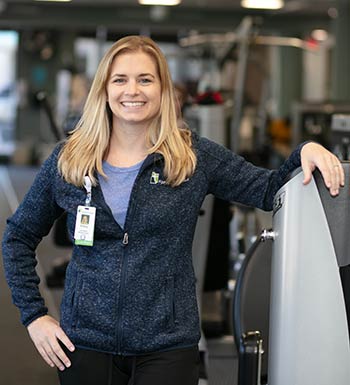
The body’s core is more than your abs. So how do you work it?

Picture that moment when you tighten your grip and pull up the weight—not only are your arm muscles engaged, but you feel your back and stomach muscles working hard, too, even straining a bit.
And your first frustrated thought is, “Who put the milk so far back in the fridge?”
No, you don’t need to be a weightlifter to understand the importance of the core muscles. Day-to-day tasks such as picking up groceries, doing housework, and even just maintaining good posture are dependent on this group of muscles, which—contrary to popular belief—go beyond the belly’s six-pack.
“People tend to think your core is just your abs, but it really is your whole midsection,” explains Brittany Hartl, Wellness Coordinator for St. Joseph’s/Candler. “The core is made up of our front, back, and side muscles, and there are four different sets of abdominal muscles alone. So one set of exercises, such as straight sit-ups, is not going to work all of your core.”
Hartl has been helping people with their core for nearly two decades. Her first job out of college was as a home health aide. Part of that job was teaching both her patients and their caregivers ways to keep their core strong to prevent falls or injuries. Later, she joined St. Joseph’s/Candler as an exercise physiologist in the Wellness Center, teaching clients how to engage their core no matter what the activity may be—even just sitting or standing.
“Engaging the core means properly contracting the core muscles, which encourages stability when performing a task,” Hartl says. “So all of the classes at the Wellness Center incorporate core exercises, whether it’s a yoga class or circuit training.”

Even as training techniques have advanced, the core principles (pun intended) have not changed.
“Over the last 18 years, my mindset around the core remains the same; however, I have incorporated additional concepts to it,” Hartl says. “After having children, I realized how important it was to heal the core by using traditional core exercises paired with deep breathing techniques that focus on the diaphragm and pelvic floor in particular. This assists with better posture and will optimize core strength.”
Another concept that seems to persist is actually a misconception—about the infamous “six-pack.”
“Some people believe you need to see a six-pack to have a strong core,” Hartl says. “But abdominal belly fat on top of your core muscles does not mean you do not have a strong core underneath. People become frustrated when they are strength training but don’t see the ‘six-pack’ results. They may tell themselves that they ‘have no core.’”
In fact, the two issues are separate when it comes to your fitness routine.
“A person’s core may in fact be very strong, but they need to work on their diet to reduce overall body fat percentage to become more lean,” Hartl says. “That’s what allows those muscles to become more visible.”
This means that if you’ve been struggling to do sit-ups all day in order to get a strong core, you can leave such narrow, repetitive routines behind.
“You’ll get bored with that, anyway,” Hartl says with a laugh.
The Wellness Center at St. Joseph's/Candler
If you’re looking for a gym, the Wellness Center has something better to offer—a comprehensive health partner dedicated to enhancing your overall well-being. The expert staff at the Wellness Center goes beyond the basics of fitness, crafting individualized exercise programs that cater specifically to your personal goals.
Conveniently located at Candler Hospital in midtown Savannah, the Wellness Center gives you access to everything you need to stay motivated and active. Call 912-819-8800 to learn more or visit www.sjchs.org/WellnessCenter.
Smart Health, Smart Living - The Latest Delivered to You
Want more health stories on topics that impact the health and wellbeing of you and your family? Learn about new technology, treatment options and how you can live a smarter, healthier life in our Smart Living publication.

